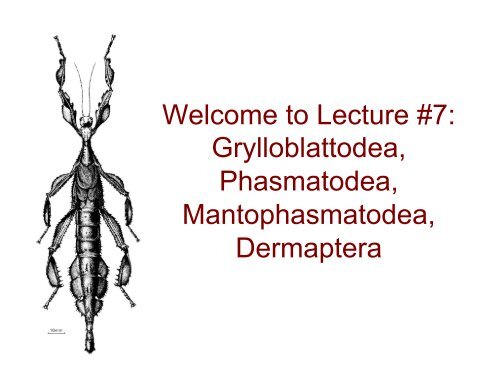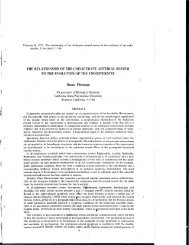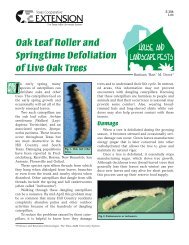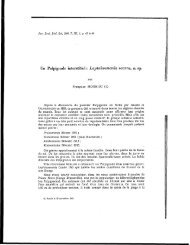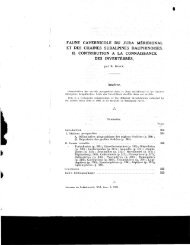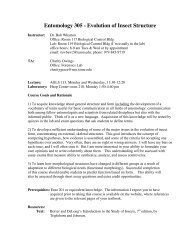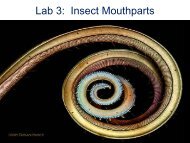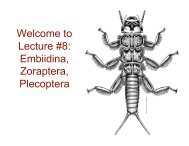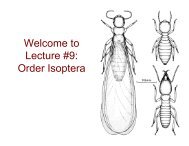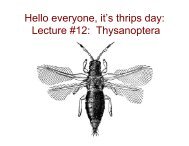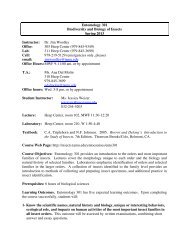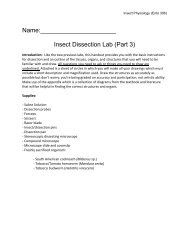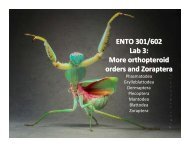Welcome to Lecture #7: Grylloblattodea, Phasmatodea ...
Welcome to Lecture #7: Grylloblattodea, Phasmatodea ...
Welcome to Lecture #7: Grylloblattodea, Phasmatodea ...
Create successful ePaper yourself
Turn your PDF publications into a flip-book with our unique Google optimized e-Paper software.
<strong>Welcome</strong> <strong>to</strong> <strong>Lecture</strong> <strong>#7</strong>:<br />
Grylloblat<strong>to</strong>dea,<br />
Phasma<strong>to</strong>dea,<br />
Man<strong>to</strong>phasma<strong>to</strong>dea,<br />
Dermaptera
Collembola<br />
Protura<br />
Diplura<br />
Microcoryphia<br />
Thysanura<br />
Ephemeroptera<br />
Odonata<br />
Apterygota<br />
Orthoptera<br />
Phasma<strong>to</strong>dea<br />
Grylloblat<strong>to</strong>dea<br />
Man<strong>to</strong>phasma<strong>to</strong>dea<br />
Dermaptera<br />
Plecoptera<br />
Embiidina<br />
Paleoptera<br />
Zoraptera<br />
Isoptera<br />
Man<strong>to</strong>dea<br />
Blat<strong>to</strong>dea<br />
Hemiptera<br />
Thysanoptera<br />
Pscoptera<br />
Phthriptera<br />
Coleoptera<br />
Neuroptera<br />
Hymenoptera<br />
Trichoptera<br />
Lepidoptera<br />
Siphonaptera<br />
Mecoptera<br />
Strepsiptera<br />
Diptera<br />
Today<br />
Phylogeny of Hexapoda<br />
(text figure 6-1)
Phylogeny of Hexapoda<br />
Orthoptera<br />
Phasma<strong>to</strong>dea<br />
Grylloblat<strong>to</strong>dea<br />
Man<strong>to</strong>phasma<strong>to</strong>dea<br />
Dermaptera
Order Phasma<strong>to</strong>dea<br />
- Walkingsticks and<br />
Leaf Insects<br />
• tarsi usually 5-segmented!<br />
• cerci short, 1-segmented!<br />
• no tympanum, no stridula<strong>to</strong>ry organs!<br />
• fore and hind legs not modified!<br />
• oviposi<strong>to</strong>r short and concealed!<br />
• biting/chewing mouthparts; herbivores!<br />
• North America species wingless, stick-like!
Phasma<strong>to</strong>dea
Heteronemiidae - common walkingsticks
Eggs of<br />
Phasma<strong>to</strong>dea
Heteronemiidae -<br />
common<br />
walkingsticks
Heteronemiidae -<br />
common<br />
walkingsticks
Heteronemiidae -<br />
common<br />
walkingsticks
Pseudophasmatidae
Pseudophasmatidae<br />
Some Pseudophasmatidae<br />
produce defensive secretions<br />
from glands in prothorax
Leaf Insects
Phasma<strong>to</strong>dea
Phasma<strong>to</strong>dea
Phasma<strong>to</strong>dea
Grylloblat<strong>to</strong>dea -<br />
• eyes small or absent!<br />
• wingless!<br />
Rock Crawlers<br />
• slender and elongate, pale and pubescent!<br />
• antennae long and filiform, 23-45 segments!<br />
• female with sword-shaped oviposi<strong>to</strong>r!<br />
• cerci long, 5- or 8-segmented!<br />
• One family in North America – Grylloblattidae!
• eyes small or absent!<br />
• wingless!<br />
• slender and elongate, pale and pubescent!<br />
• antennae long and filiform, 23-45 segments!<br />
• female with sword-shaped oviposi<strong>to</strong>r!<br />
• cerci long, 5- or 8-segmented!<br />
Grylloblattidae
Man<strong>to</strong>phasma<strong>to</strong>dea -<br />
Heelwalkers<br />
The newest order of insects!
Man<strong>to</strong>phasma<strong>to</strong>dea<br />
• Rather small, generally 2-3 mm!<br />
• both sexes are wingless!<br />
• chewing mouthparts!<br />
• hypognathous!<br />
• antennae are long and filiform!<br />
• tarsi are 5-segmented!
Man<strong>to</strong>phasma<strong>to</strong>dea<br />
one family – Man<strong>to</strong>phasmatidae
Man<strong>to</strong>phasma<strong>to</strong>dea
Order Dermaptera -<br />
Earwigs<br />
• cerci modified as pincers or<br />
forceps!<br />
• biting/chewing and prognathous<br />
mouthparts!<br />
• fore wings reduced <strong>to</strong> short<br />
tegmina!<br />
• hind wings, when present, large<br />
and folded up beneath tegmina<br />
at rest!<br />
• tarsi 3-segmented!
Order Dermaptera - Earwigs<br />
• fore wings<br />
reduced <strong>to</strong> short<br />
tegmina!<br />
• hind wings, when<br />
present, large and<br />
folded up beneath<br />
tegmina at rest!<br />
• tarsi 3-<br />
segmented!
Order Dermaptera - Earwigs<br />
• fore wings<br />
reduced <strong>to</strong> short<br />
tegmina!<br />
• hind wings, when<br />
present, large and<br />
folded up beneath<br />
tegmina at rest!<br />
• tarsi 3-<br />
segmented!
Many earwigs have<br />
maternal care
Forficulidae - European and<br />
Spine-Tailed earwigs
Forficulidae - European and<br />
Spine-Tailed earwigs<br />
Distal part of<br />
second tarsal<br />
segment dilated,<br />
broader than<br />
3rd tarsal<br />
segment
Anisolabididae - Seaside and<br />
Ring-Legged Earwigs<br />
(antenna<br />
with 14-24<br />
segments)
(antenna<br />
with 25-30<br />
segments)<br />
Labiduridae
Labiduridae


